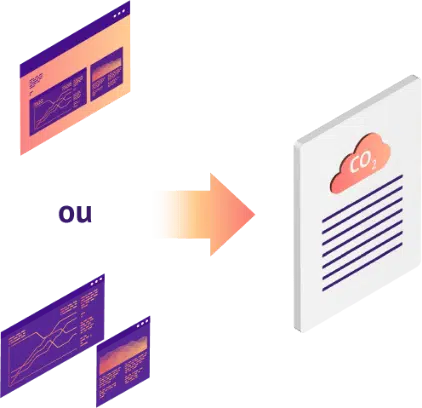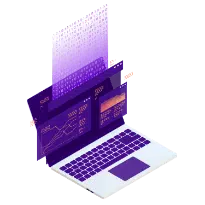Published 13/01/2023
The level of commitment from companies and local authorities to carbon neutrality is varied, just like that of individuals. While some are very proactive, even precursors, others are moving forward at a much slower pace. While complex, greenhouse gas assessment and carbon offsetting are crucial for CSR managers. Regardless of their level of commitment, they need tools and methods to facilitate these projects. Apart from the possibility for the company to produce part of its energy on site (through wind turbines, photovoltaic panels...) and thus green its energy mix, energy sobriety and performance remain the two major levers for all companies to reduce their energy consumption and thus further reduce their carbon footprint.
What are the keys to facilitating your GHG assessment? How can you go further and optimize carbon offsets? In this article, we give you a brief overview.
01
Tracking Your Energy Consumption and Carbon Footprint: One Software or Two?
There are two possible solutions available for a company to establish their carbon reporting:
Either use an energy management system and, separately, a specific tool dedicated to the company's carbon footprint,
Or use an advanced energy management system which includes a carbon footprint module.

Each solution has its advantages and disadvantages. On paper, software dedicated to calculating GHG emissions allows you to go further, particularly in calculations related to scope 3 (emissions generated by the company's suppliers and service providers, upstream and downstream of its activity). But beware, many carbon accounting platforms use approximate data, based, for example, on financial data (invoices) to estimate greenhouse gas emissions. Retrieving more physical consumption data in real time is a guarantee of reliability. The more generic data is used, the more difficult it is to measure the results of actions.
If you choose to use two tools, you will have to connect them anyway - which can be complicated at times. It is therefore easier to have one centralized tool for an accurate and comprehensive approach. EMOS makes it possible to integrate GHG emissions data and certain ESG criteria in the same reporting. And Energy Management Systems continue to make progress in this direction, regularly adding more and more advanced functionalities.
02
Improve Carbon Monitoring with an Energy Management System

While the legal obligation is to calculate and track GHG emissions, not necessarily to reduce them, it is clear that this has financial and sustainable benefits. Saving on carbon also means saving millions of euros. This has become even more clear with the huge increase in electricity and gas prices.
Under the GHG protocol, and even more so if it is combined with the ISO14064-1 certification, it is always necessary to measure, monitor, and control GHG emissions. This is where energy monitoring software must be in line with the ambitions and challenges, thanks to a more structured and controlled monitoring of the carbon aspect of energy.

GHG Protocol: How Can Going Digital Help You Comply?
An Energy Management System offers multiple functionalities which can help with energy consumption analysis:
Data centralization (data recovery via insertion solutions for a multi-site and multi-actor approach) in real time.
A visual workspace that facilitates the understanding, reading, and accessibility of data.
Consideration of energy source disparity (and therefore GHG emission disparity) and comparative analysis.
Distinction between direct (scope 1) and indirect emissions (scope 2) and classification according to their scope (organizational or operational).
Database of emission factors (representative value generated by activity when direct measurement is not possible): rich, updated, and modifiable database to adapt to activity, which results in data closer to reality.
An Energy Management System then allows you to define, monitor, and control your objectives and sub-objectives with great precision. This is achieved by building a basic scenario, and also by elaborating complementary simulations, obtained by modifying the rhythm of the actions, according to what they cost or yield.

How can you respond to the energy crisis? We spoke to the Managing Director of OMNEGY to hear what he had to say.
With the Energy Management Module, the GHG balance is calculated without any particular difficulty in scopes 1 and 2 with the country's energy mix on one side and the company's electricity and gas consumption on the other.
However, if the company is aiming for zero carbon, the carbon offset mechanism comes into play.
03
Personalize Your Carbon Offsets with Real-Time Data
Putting in place a plan to reduce KWh and GHGs by 30% within 5 years and by 80% by 2040, or even to achieve zero carbon: this is the type of ambition displayed by some companies since COP26 in 2021.
This is particularly true of companies that have joined or are joining the Science-Based Target Initiative (SBTi) or those subject to the European Union Emissions Trading System.

Carbon Markets: How can you Stay Ahead of the Game?
The carbon impact linked to the purchase of energy by the company is included in the calculation of indirect emissions, i.e. in scope 2. It is understood that when a company buys "green" energy, its responsibility is to buy the best it can within the framework of its Power Purchase Agreement.
For companies that have to activate the carbon offset mechanism, most of the time, the calculation is based on the energy mix of the country concerned. But some large companies go further, and NGOs sometimes encourage them to do so, by wanting to calculate their carbon impact precisely, and thus be fully involved in their decarbonization, with full knowledge of their energy consumption and greenhouse gas emissions. Indeed, a kwh does not emit the same amount of carbon depending on whether it is produced in July at 2pm or in November at 6am! And this becomes more pronounced with the increase in renewable energy sources. Peak carbon emissions do not necessarily correspond to off-peak or peak hours. The company can internalize this calculation of carbon emissions but this requires very specialized skills. The most common solution is to ask your energy supplier to calculate the real compensation, day by day and hour by hour, on a given site. The detailed energy monitoring, based on real time consumption, finds a new utility here. The company can then implement the carbon offset mechanism with precision, either by purchasing green certificates directly, or by imposing a decarbonized energy on its supplier (who will compensate within the framework of its Power Purchase Agreement, or by purchasing certificates of origin). However, this will be done on the basis of the company's actual carbon footprint, to be entered in scope 2.

KEY POINTS
TO REMEMBER
For all companies that publish their GHG report, mandatory or not, and whatever the impact of the process on the company's global strategy, finding the keys to facilitate the production of this report is always a challenge. A good Energy Management System integrating a GHG assessment module makes it easy to compile the necessary elements for scopes 1 and 2. It helps to understand the impact of the company's activity in the world, thanks to the aggregation of different data, from different actors and different places, quickly. It also allows, if the company enters into a more complete decarbonization process, to customize the calculation of its carbon offsets, thanks to the monitoring of consumption in real time.
All these elements - to which we can add the monitoring of prices on the energy markets - are provided to CSR managers who, in order to fully implement a carbon strategy, must also manage it and quantify it financially.
Are you a property manager looking to become more sustainable and efficient?

